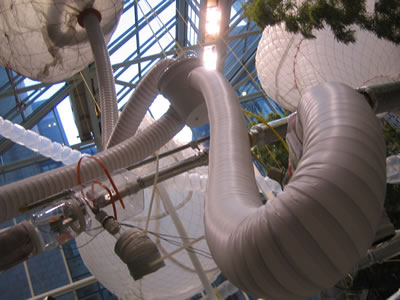
“For Überorgan I felt that I was going to have a real strong physical presence, but I felt like it needed to also have this kind of audible component. They look like these kind of whales suspended in the air and hovering about you..." -- Tim Hawkinson
 Listen to a sample of the massive Überorgan Listen to a sample of the massive Überorgan
The Uberorgan functions in much the same way as a bagpipe, a bladder of pressurized air blows air through a reed to produce a sound. Uberorgan is different from a bagpipe in that it uses a single bag of air to produce a single sound as opposed to a single bag producing a range of sounds through the use of a “chanter”. Therefore, the uberorgan is composed of several different bags or bladders; each attached to a reed and then amplified by a horn. The bags of the bagpipes are composed of a series of plastic inflatables under tremendous amounts of pressure which are then contained and formed through the use of fish nets. |
|

Control of the sound generated by each bagpipe is done through a self styled keyboard composed of photosensitive switches. Covering a switch blocks light to the sensor thereby activating a key which in turn tells a valve to release air through the reed.
Covering a switch is accomplished through the use of a scrolling sheet of mylar with painted black bars, similar to player pianos of the early 20th century. Hawkinson describes his device as a light sensitive piano.
The music played by uberorgan is a score composed by Hawkinson based on old Pentecostal church hymns and Swan Lake . To avoid a score that is too repetitive and predictable, Hawkinson included the use of filters, key shifters and scale inverters, which randomly adjusted the sound of each note, resulting in a more diverse range of sound.
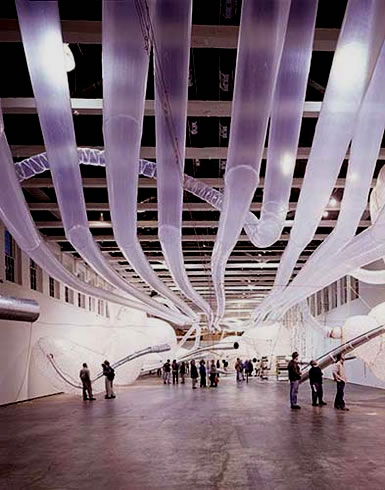
The photo above gives some perspective of the massive size of Tim Hawkinson's Uberorgan creation |
|
| Uberorgan |
Imagined and created by artist Tim Hawkinson, the Uberorgan (or Überorgan) was initially created for a 15,000 square foot gallery at MassMOCA in 2001. The challenge of filling the volume of the gallery is what gave birth to the Uberorgan: how to create something that had a strong visual presence in such a large volume of space while simultaneously having strong auditory presence. The result was accomplished by Hawkinson adjusting his process by building models of the space to study how he would accomplish filling the space and avoid being caught “shorthanded”. The final product involved a series of large scale balloons that were effectively large bagpipes producing music.
"Several bus-size biomorphic balloons, each with its horn tuned to a different in the octave, make up a walk-in self-playing organ. A 200 foot-long scroll of dots and dashes encodes a musical score of old hymns, pop classics, and improvisational ditties. This score is deciphered by the organ's brain - a bank of light sensitive switches - and then reinterpreted by a series of switches and relays that translate the original patterns into non-repeating variations of the score."
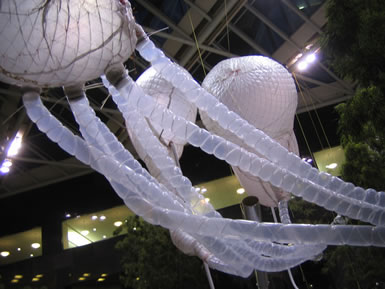
"Uberorgan" is a massive musical machine that encompasses the six rooms. The one piece of sculpture is the show. The complexity in the organization of each functional part as it relates to the whole is staggering. Like being on a large sailboat mixed with a player piano mixed with a hot air balloon. This "musical" instrument manages to be mechanically overt, where its exposed form follows function, while at the same time representational. Its organic form is molded after the interior organs of the human body. A thin net held together by hundreds of plastic clamps keep the floating forms in place. The stitching together of the white nylon fabric, inflated by massive air pumps above the high ceilings, recalls rigging on sails of a ship. The stitching is the only aspect of the installation that Hawkinson did not do himself. This white material, used as a skin for the giant wind instrument, could easily have made the "Uberorgan" feel like a piece of cold machinery. But ultimately it does not. The warm hues of the extension chords and the web-like binding materials imbue a vascular quality on the synthetic tissue. -- Moshun Jacker
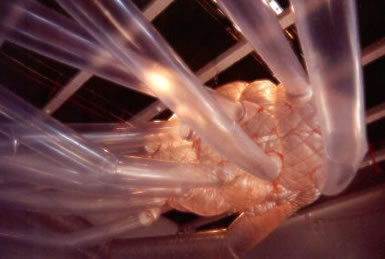  Listen to another sample of the Überorgan Listen to another sample of the Überorgan
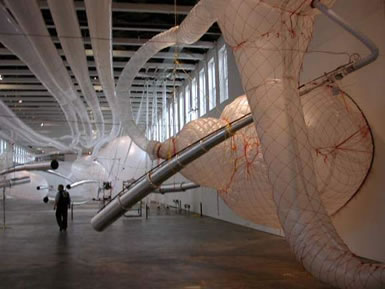
Original Uberorgan installation in MassMOCA in 2001
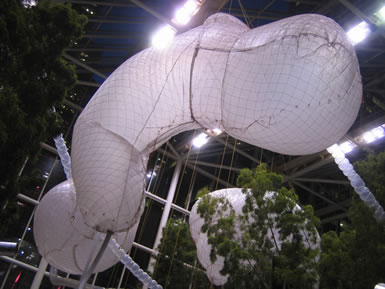
Uberorgan in New York City in 2005. The Uberorgan will travel to the Getty Museum in Los Angeles in 2007
|
|
